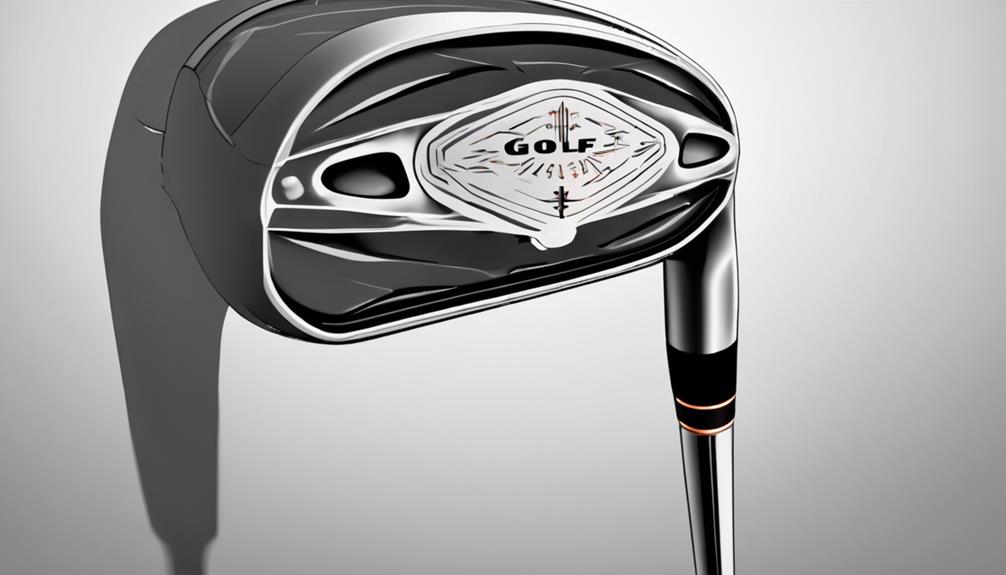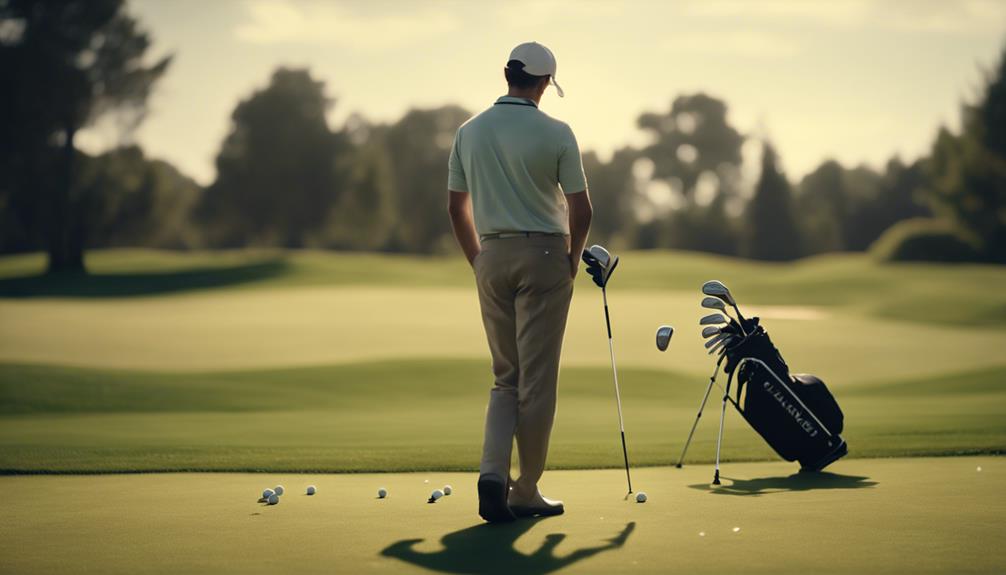- 7 Top Flite Golf Clubs XL for Improved Performance - September 28, 2024
- Top Flite Golf Clubs: Top 5 Reasons to Choose Them - September 28, 2024
- Top 3 Golf Club Fitters for a Perfect Swing - September 28, 2024
When you see the marking 'P' on a golf club, it represents the Pitching Wedge, a versatile club designed for approach shots with a moderate loft angle of 44 to 48 degrees. This club is ideal for shots within 100-130 yards, making it an essential part of your short game. You may also see a number alongside the 'P', indicating the specific loft in degrees. Understanding what the 'P' means is just the beginning – with this knowledge, you'll be able to choose the right club for your distance and shot needs, and you'll want to explore more about how to master your game with the Pitching Wedge and other specialized clubs.
Key Takeaways
- 'P' on golf clubs stands for Pitching Wedge, designed for approach shots with a moderate loft angle of 44 to 48 degrees.
- The Pitching Wedge is effective for shots within 100-130 yards, primarily used for approach shots, chipping, and pitching.
- The 'P' may include a number (e.g., P43) indicating the specific loft in degrees.
- Familiarity with the 'P' designation is essential for selecting the right club for distance and shot needs, enhancing short-game performance.
Understanding Golf Club Markings
When examining your golf clubs, you'll notice a variety of markings, including numbers, letters, and symbols, which serve as fundamental identifiers of each club's purpose and characteristics.
Among these markings, the letter 'P' is particularly significant, as it stands for Pitching Wedge, a club designed for approach shots to the green with a moderate loft angle.
The 'P' marking is important in helping you quickly identify the club's purpose, especially for shots that require accuracy around the green.
You may also notice that the 'P' is sometimes accompanied by a number, such as P43, indicating the specific loft in degrees of that pitching wedge.
Understanding the meaning of the 'P' designation is essential in selecting the right club for particular distance and shot requirements.
What Is a Pitching Wedge?
How does a club specifically designed to help you conquer approach shots from moderate distances fit into your overall golf strategy? The pitching wedge is an important addition to your golfers' bag, providing a higher trajectory for short-range shots with its loft angle ranging from 44 to 48 degrees. This club is commonly used for shots requiring precision, such as chipping and pitching around the green, facilitating the ball's quick stopping ability.
| Characteristics | Description |
|---|---|
| Loft Angle | 44-48 degrees |
| Distance Range | 100-130 yards |
| Shot Type | Approach shots, chipping, pitching |
| Position in Iron Set | Typically follows the 9-iron |
As you master your approach shots, the pitching wedge becomes an essential tool in your iron set. With its unique loft angle and distance range, it's designed to help you navigate those tricky moderate distances. By understanding the pitching wedge's capabilities, you can confidently add it to your arsenal and take your game to the next level. By incorporating this club into your strategy, you'll be better equipped to tackle challenging approach shots and improve your overall performance on the green.
Wedges Vs. Irons Explained

You're likely wondering what sets wedges apart from irons, and why they're both necessary components of a well-rounded golf game. The key difference lies in their design and purpose.
Wedges, including the Pitching Wedge (marked with the letter 'P'), have higher lofts compared to standard irons, typically ranging from 44-48 degrees. This increased loft allows for more precision and control around the green, making them ideal for short-range shots.
In contrast, irons are numbered from 1 to 9, with lower-numbered irons designed for longer, lower shots, and higher-numbered irons providing higher trajectories for shorter distances. While both are used for approach shots, wedges are specifically designed for finesse shots around the green, whereas irons are more versatile for various distances and lies on the course.
The pitching wedge is often included in a standard iron set, but specialized wedges like sand wedges and lob wedges offer even higher lofts for specific short game scenarios.
Choosing the Right Golf Club
Selecting the right golf club for each shot is essential, as it directly impacts your performance and overall score. When you're faced with a challenging approach shot, you need to choose a club that will give you the right balance of distance and accuracy. As you're deciding, remember that understanding the specific purpose of each club designation can greatly enhance your shot selection.
Here are some key factors to take into account when choosing the right golf club:
- Club designation: Familiarize yourself with the letters on your clubs, such as 'P' for Pitching Wedge, 'A' for Approach Wedge, and 'S' for Sand Wedge.
- Loft angles: Know the loft angles of your clubs, as this will help you select the right club for the shot you're facing.
- Shot selection: Reflect on the type of shot you need to make, whether it's a short-range approach shot or a chip shot from the sand.
Importance of Loft Angle

When it comes to choosing the right golf club, grasping the concept of loft angle is vital, as it considerably affects the ball's trajectory and distance. You need to understand that the loft angle, measured in degrees, determines how high and far the ball will travel.
Clubs with lower loft angles, like drivers, produce lower ball flights that maximize distance, while higher loft angles, like those found in wedges, create higher trajectories for more control and precision.
As you prepare for different shots, it's important to select the appropriate club based on the loft angle. For instance, pitching wedges typically have loft angles ranging from 44 to 48 degrees, making them ideal for shots that require a higher trajectory and more spin.
The difference in loft angles between clubs, usually around 4 to 6 degrees, allows you to achieve consistent distance gaps, enabling more effective club selection based on the distance to the target.
Golf Club Numbers and Types
Golf clubs are categorized into different types, each designated by a number or letter, such as the 'P' club, which serves a specific purpose in your golf bag. Understanding the various types of clubs used in golf can help you make informed decisions about which clubs to use in different situations.
Here are four key points to take into account:
- Pitching Wedge (P): Suitable for short-distance shots with a moderate loft angle, typically between 44 to 48 degrees.
- Golf Club Numbers: Irons are numbered from 3 to 9, with higher numbers corresponding to higher loft angles and shorter distances.
- Club Types: In addition to the Pitching Wedge, other wedges include the Sand Wedge (S) and Lob Wedge (L), each with its own unique loft angle and purpose.
Irons for Approach Shots

You'll typically reach for irons like the pitching wedge when you're facing approach shots from moderate distances, usually between 100-130 yards out. As the letter 'P' on your golf club, the pitching wedge is designed for these situations, offering a higher loft angle of 44 to 48 degrees. This allows for a higher trajectory and better control on approach shots, making it an essential club in your bag.
When you master the pitching wedge, you'll notice a significant improvement in your short game. The club's design provides enhanced spin and stopping power, making it perfect for chipping and pitching around the green. A well-executed pitching wedge shot can lead to more accurate approaches to the hole, ultimately contributing to lower scores.
To take your game to the next level, focus on developing a consistent swing with your pitching wedge. Practice will help you understand the club's capabilities and limitations, allowing you to make more informed decisions on the course. By honing your skills with the pitching wedge, you'll be well on your way to mastering your short game and shooting better scores.
Wedges for Short-Range Shots
In addition to the pitching wedge, other wedges in your bag are designed to tackle even shorter-range shots, typically within 100 yards of the green. These specialized wedges are engineered to provide more precision and control for delicate approach shots.
Here are some key characteristics of these shorter-range wedges:
- Higher loft angles: With loft angles ranging from 50 to 60 degrees, these wedges produce an even higher trajectory, allowing for more accurate and controlled landings on the green.
- Increased spin: The higher loft and more aggressive grooves on these wedges generate more spin, enabling you to stop the ball quickly and maintain control on the green.
- Softer landings: The higher trajectory and increased spin of these wedges result in softer landings, reducing the risk of the ball rolling away from your target.
Mastering these shorter-range wedges will greatly improve your short game, giving you the confidence to tackle even the most challenging approach shots.
Club Selection for Beginners

Mastering the short game with specialized wedges is just one part of the equation; now, it's time to focus on selecting the right clubs for your overall game, especially as a beginner.
When it comes to club selection for beginners, it's important to start with the basics. You'll want to begin with a 7-iron, which provides a great balance of distance and control, making it easy to use and versatile.
Additionally, having a set of clubs that includes both a pitching wedge (PW) – marked with the letter 'P' – and a sand wedge will help you cover various short game situations.
Understanding the loft numbers on clubs will also help you select the right club for specific distances. For instance, a 5-iron typically hits the ball around 170 yards.
As you practice, you'll develop your skills and learn when to use each type of club effectively. Remember, practicing with a mix of irons and wedges will help you master your game.
With the right clubs and practice, you'll be well on your way to improving your overall game.
Mastering Golf Club Knowledge
Understanding the nuances of golf club designations is essential for selecting the right club to execute a precise shot, and one of the most important designations to grasp is the letter 'P', which denotes a pitching wedge.
As you endeavor to master your golf game, familiarizing yourself with club designations can greatly improve your performance.
Here are key takeaways to elevate your club selection:
- Recognize the 'P': The letter 'P' on a golf club stands for 'Pitching Wedge', designed for approach shots to the green with a loft between 44 to 48 degrees.
- Versatility matters: Pitching wedges are versatile clubs used for shots that require precision and control, often covering distances of around 100 to 130 yards for average golfers.
- Short game mastery: Understanding the 'P' designation helps you select the right club for short-range shots requiring a higher trajectory, enhancing your overall short game.
Frequently Asked Questions
What Does 4pw Mean in Golf Clubs?
When you see "4PW" on golf clubs, you're getting a set that combines a 4-iron for longer approach shots with a pitching wedge for precision shots, offering versatility in your iron set and flexibility with club loft variations.
When to Use Pitching Wedges?
When steering the course, you'll find yourself in situations where precision is key; that's when you should whip out your trusty pitching wedge, mastering techniques for ideal distance control and short game strategies, considering loft angle importance to select the right club.
What Does the a Stand for on a Golf Club?
You're wondering what the "A" stands for on your golf club? It's an acronym for Approach Wedge, a club type with 50-54 degrees of loft, designed for precise shots within 100 yards of the pin, enhancing your short-game versatility.
What Does W Mean on Golf Club?
When you see 'W' on a golf club, you're looking at a wedge, designed for short-range shots requiring precision and control, with varying types like pitching, sand, and lob wedges, each with unique club specifications for ideal short game and distance control.
Conclusion
You've now got a solid grasp of golf club markings, including the mysterious 'P' on your pitching wedge.
As you take to the course, remember that 75% of all golf shots are made within 100 yards of the green, making wedges an essential part of your game.
With practice and patience, you'll be dialing in your club selection and sinking birdies in no time.
Mastering golf club knowledge is key to improving your overall game – and maybe even joining the ranks of the pros!




